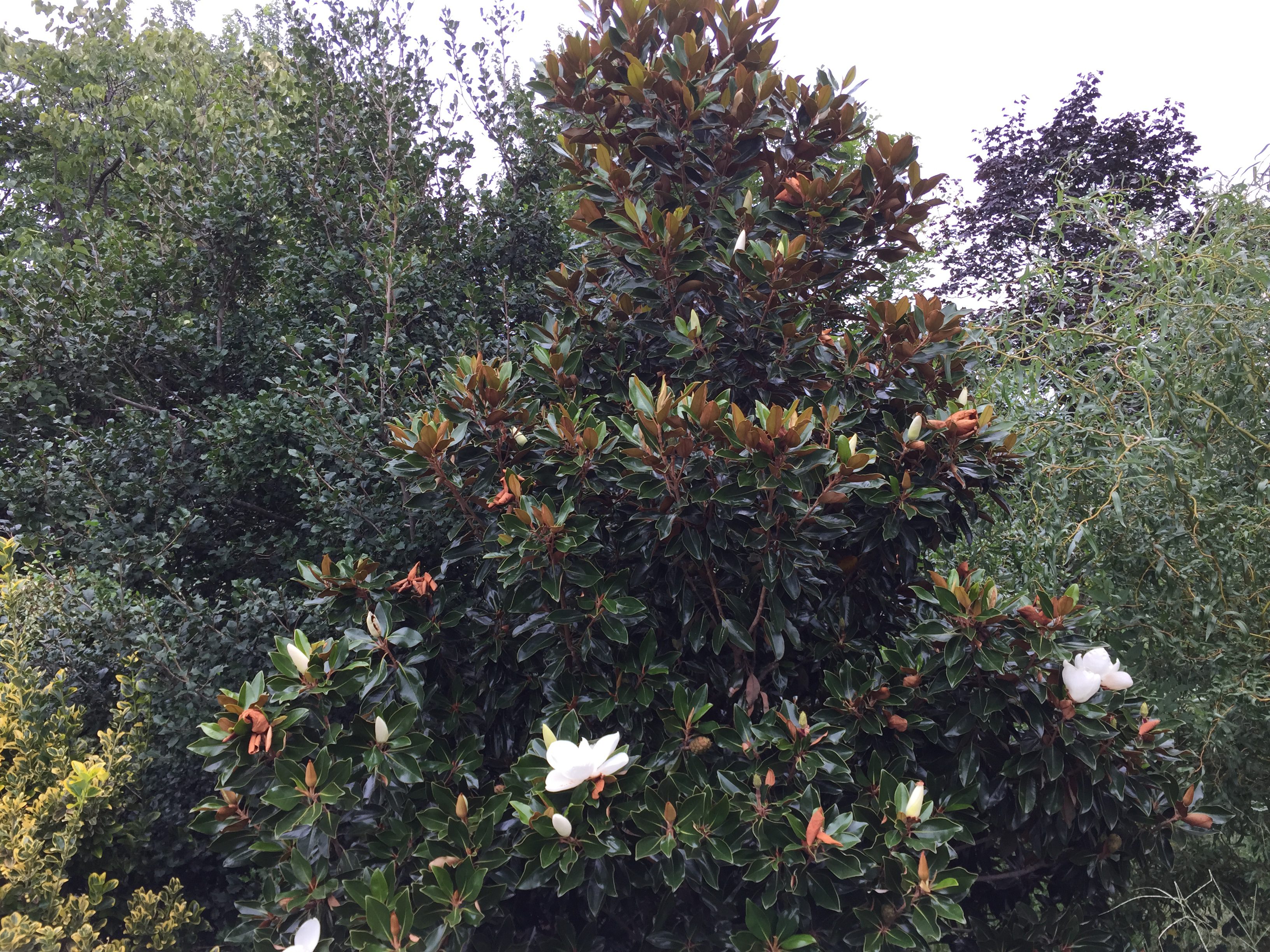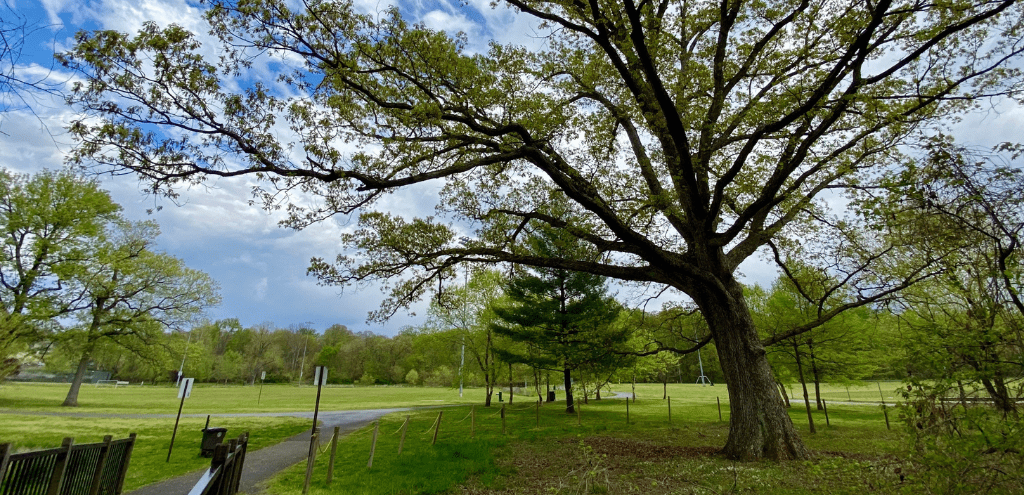
Large trees are a majestic presence in our environment that provide numerous benefits to both humans and all living things. Their towering height and broad canopies offer shade and respite from the hot sun, creating a cool and comfortable environment for people to enjoy outdoor activities. Additionally, the shade provided by these trees can reduce energy costs by keeping buildings and homes cooler, while also improving air quality and providing habitat for wildlife.
In DC, we’re fortunate to not only have access to a multitude of parks and greenspaces but also legal protections that preserve some of the largest, oldest, and shadiest trees in the District. It’s a known fact that we love our large canopy trees, so we’re featuring them today! Read on to learn about the 5 largest tree species that can be found in DC and how you can get them planted at your home for FREE!
Tulip Poplar | Liriodendron tulipifera
 Tulip poplars are tall and fast-growing trees that are native to eastern North America. They are known for their distinct tulip-shaped leaves and beautiful yellow-green flowers that bloom in the spring. Tulip poplars can grow up to 120 feet tall and have an especially straight trunk; so straight in fact that tulip tree logs were hollowed out by Native Americans for use as canoes. Today, they are used among landscapers and are often planted in parks and residential areas for their shade and aesthetic appeal. Its beautiful flowers, furrowed bark, and tulip-shaped leaves make it a beautiful shade tree. Tulip poplars are also quite POPuLAR – the species is tied with the Bald Cypress as Casey Trees’ most planted large tree species! Learn how you can get this tree planted for FREE or get up to $100 back for planting this tree yourself through our tree rebate program.
Tulip poplars are tall and fast-growing trees that are native to eastern North America. They are known for their distinct tulip-shaped leaves and beautiful yellow-green flowers that bloom in the spring. Tulip poplars can grow up to 120 feet tall and have an especially straight trunk; so straight in fact that tulip tree logs were hollowed out by Native Americans for use as canoes. Today, they are used among landscapers and are often planted in parks and residential areas for their shade and aesthetic appeal. Its beautiful flowers, furrowed bark, and tulip-shaped leaves make it a beautiful shade tree. Tulip poplars are also quite POPuLAR – the species is tied with the Bald Cypress as Casey Trees’ most planted large tree species! Learn how you can get this tree planted for FREE or get up to $100 back for planting this tree yourself through our tree rebate program.
Bald Cypress | Taxodium distichum
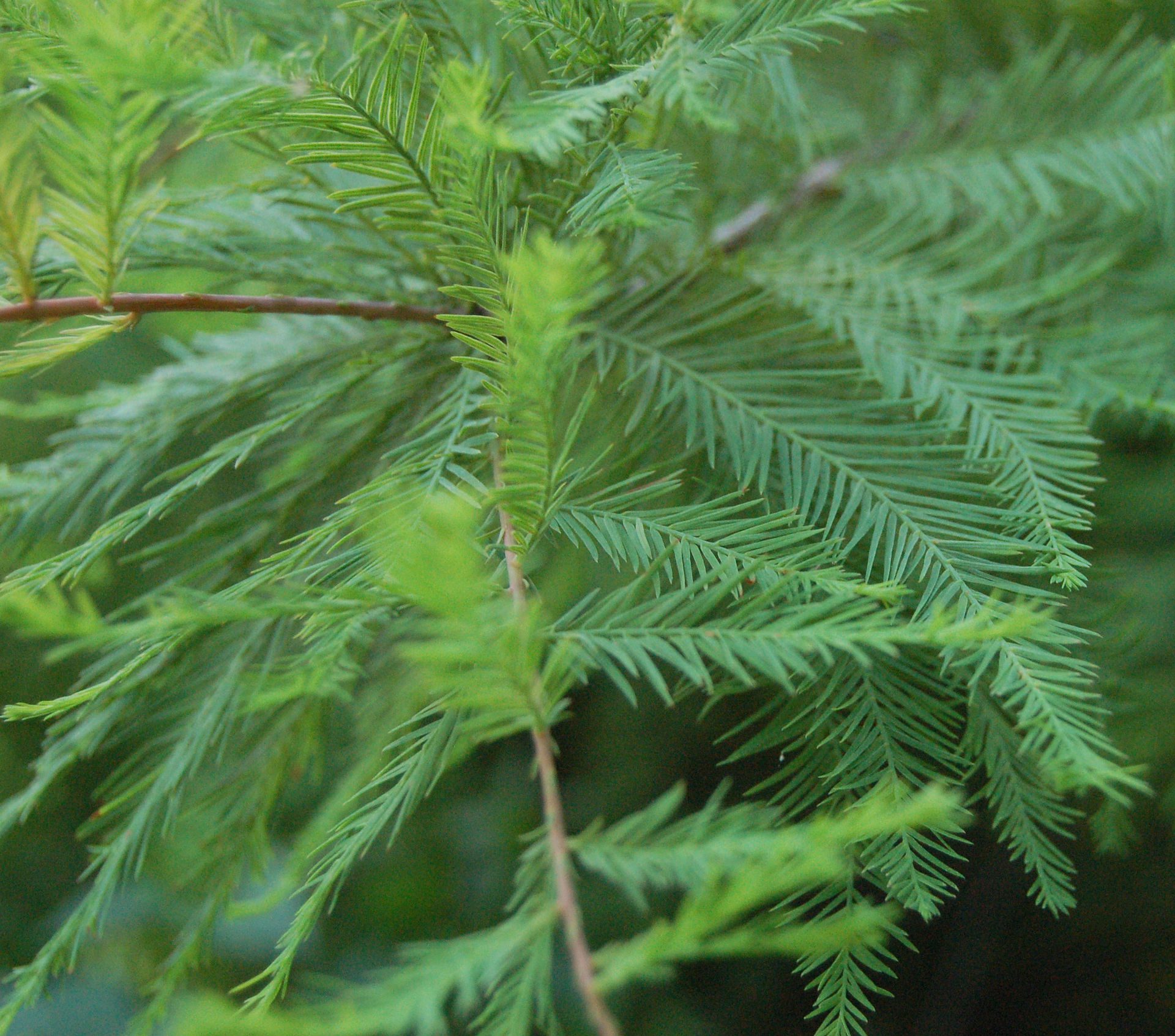 A graceful tree with dark shaggy bark, light-green leaves, and a grand pyramidal shape, the bald cypress is a tough, urban tree valued by wildlife for its seed. It is called “bald” because it drops its leaves in the fall – uncommon for trees bearing cones. The bald cypress is well adapted to grow in wetland environments, as it has developed a unique system of “knees” that grow out of its roots to help it breathe in oxygen-poor soil. Additionally, the bald cypress is known for its long lifespan, with some trees estimated to be over 600 years old. Learn how you can get this tree planted for FREE or get up to $100 back for planting this tree yourself through our tree rebate program.
A graceful tree with dark shaggy bark, light-green leaves, and a grand pyramidal shape, the bald cypress is a tough, urban tree valued by wildlife for its seed. It is called “bald” because it drops its leaves in the fall – uncommon for trees bearing cones. The bald cypress is well adapted to grow in wetland environments, as it has developed a unique system of “knees” that grow out of its roots to help it breathe in oxygen-poor soil. Additionally, the bald cypress is known for its long lifespan, with some trees estimated to be over 600 years old. Learn how you can get this tree planted for FREE or get up to $100 back for planting this tree yourself through our tree rebate program.
Sweetgum | Liquidambar styraciflua
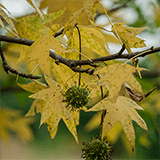 The American Sweetgum tree, also known as Liquidambar styraciflua, is a deciduous tree that is native to the eastern United States. It is known for its distinctive star-shaped leaves, which turn beautiful shades of red, orange, and yellow in the fall. The tree also produces spiky, ball-shaped fruits that are sometimes used for crafts or as natural decorations and is prized by local wildlife. There exists a cultivar of American Sweetgum called “Happidaze”, which is known for its more rounded leaves and lack of fruit, often planted in urban environments. The tree’s resin has been used for medicinal purposes in the past, and its leaves have been used as a natural insect repellent. Learn how you can get this tree planted for FREE or get up to $100 back for planting this tree yourself through our tree rebate program.
The American Sweetgum tree, also known as Liquidambar styraciflua, is a deciduous tree that is native to the eastern United States. It is known for its distinctive star-shaped leaves, which turn beautiful shades of red, orange, and yellow in the fall. The tree also produces spiky, ball-shaped fruits that are sometimes used for crafts or as natural decorations and is prized by local wildlife. There exists a cultivar of American Sweetgum called “Happidaze”, which is known for its more rounded leaves and lack of fruit, often planted in urban environments. The tree’s resin has been used for medicinal purposes in the past, and its leaves have been used as a natural insect repellent. Learn how you can get this tree planted for FREE or get up to $100 back for planting this tree yourself through our tree rebate program.
American Sycamore | Platanus occidentalis
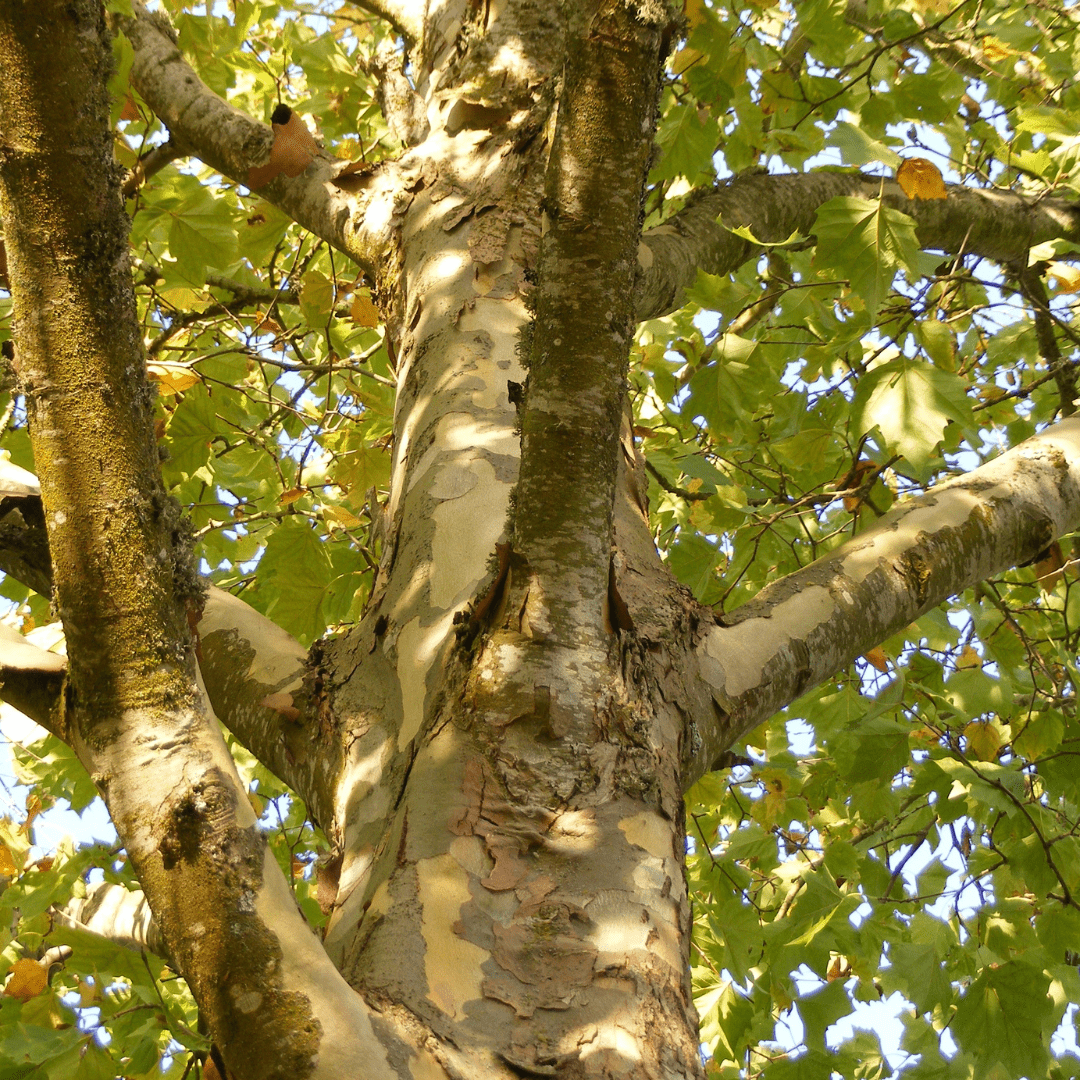 The American Sycamore is a large deciduous tree that can grow over 100 feet tall and 10 feet in diameter. It is native to North America and is known for its distinctive bark, which peels off in large, irregular patches. The tree produces small, green flowers in the spring and has large, spiky seed pods that mature in the fall. Over in Montgomery County, there’s one American Sycamore measuring in at 137-feet tall with a circumference of 310 inches or 25 feet and crown spread of 108 feet. The tree can be found in Dickerson Conservation Park and was recorded in the 2013 Register of Champion Trees. Often confused for one another, Sycamore trees and London Planetrees can be differentiated by their bark and leaves. Sycamore trees have a flaky, light-colored bark that peels away in patches, while London Planetrees have a mottled, grayish-brown bark that flakes off in small squares. The leaves of sycamore trees are larger and have deeper lobes than those of London plane trees, which have smooth-edged, slightly smaller leaves. Additionally, sycamore trees tend to grow in wetter areas while London Planetrees prefer drier soils. Learn how you can get this tree planted for FREE or get up to $100 back for planting this tree yourself through our tree rebate program.
The American Sycamore is a large deciduous tree that can grow over 100 feet tall and 10 feet in diameter. It is native to North America and is known for its distinctive bark, which peels off in large, irregular patches. The tree produces small, green flowers in the spring and has large, spiky seed pods that mature in the fall. Over in Montgomery County, there’s one American Sycamore measuring in at 137-feet tall with a circumference of 310 inches or 25 feet and crown spread of 108 feet. The tree can be found in Dickerson Conservation Park and was recorded in the 2013 Register of Champion Trees. Often confused for one another, Sycamore trees and London Planetrees can be differentiated by their bark and leaves. Sycamore trees have a flaky, light-colored bark that peels away in patches, while London Planetrees have a mottled, grayish-brown bark that flakes off in small squares. The leaves of sycamore trees are larger and have deeper lobes than those of London plane trees, which have smooth-edged, slightly smaller leaves. Additionally, sycamore trees tend to grow in wetter areas while London Planetrees prefer drier soils. Learn how you can get this tree planted for FREE or get up to $100 back for planting this tree yourself through our tree rebate program.
Various Oak Species | Quercus
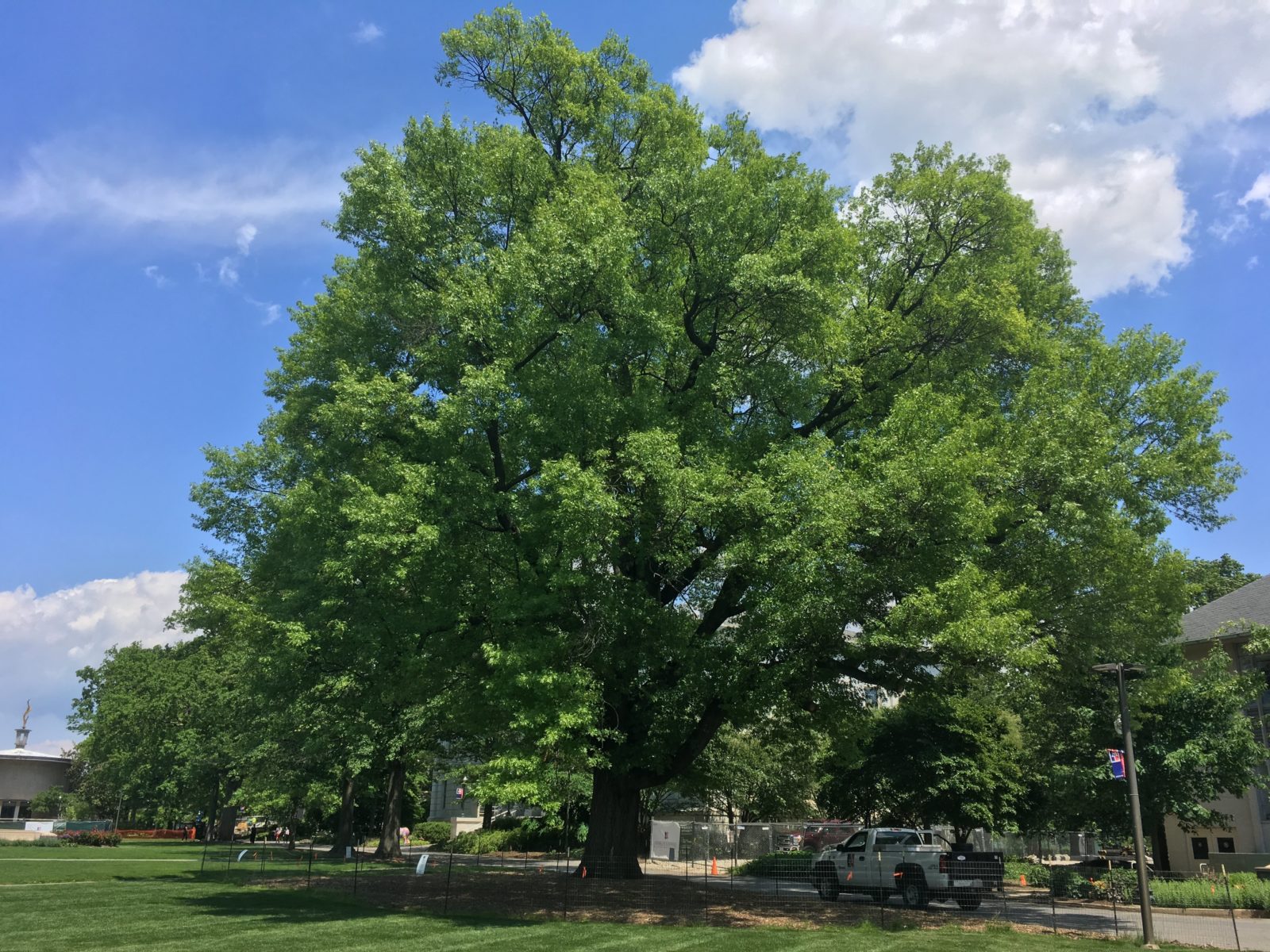 Oak trees are known for their hardiness and size, making them a popular choice for anyone seeking a shady place to relax. With over 600 different species, oak trees can range from small shrubs to towering giants. Despite their varying sizes, all varieties of oak trees are known for their tough and resilient nature, able to withstand harsh weather conditions and natural disasters. Additionally, their strong root systems make them long-lived, with some oak trees living for hundreds of years. Some of the largest Oak species that can be found in DC include the White, Nuttall, Willow, Chestnut, and the District of Columbia’s state tree, the Scarlet Oak. Learn how you can get these tree species planted for FREE or get up to $100 back for planting them yourself through our tree rebate program.
Oak trees are known for their hardiness and size, making them a popular choice for anyone seeking a shady place to relax. With over 600 different species, oak trees can range from small shrubs to towering giants. Despite their varying sizes, all varieties of oak trees are known for their tough and resilient nature, able to withstand harsh weather conditions and natural disasters. Additionally, their strong root systems make them long-lived, with some oak trees living for hundreds of years. Some of the largest Oak species that can be found in DC include the White, Nuttall, Willow, Chestnut, and the District of Columbia’s state tree, the Scarlet Oak. Learn how you can get these tree species planted for FREE or get up to $100 back for planting them yourself through our tree rebate program.
Honorable mention among DC’s large tree species also include the Honey Locust (Gleditsia triacanthos) and Southern Magnolia (Magnolia grandiflora). The Honey Locust has small, light leaves that resemble ferns. Its leaves degrade quickly once fallen – something gardeners greatly value. Southern Magnolias are ubiquitous throughout the south, with large fragrant blooms and evergreen leaves. While these two tree species do not grow quite as large as others on this list, they are still large trees that can be found all over the city. Both qualify for our tree rebate program or can be planted free for DC residents.
Trees are pieces of living history, many of them have sat and watched the ever-changing DC landscape since before we were born. We’ve learned about some of the amazing Witness trees that can be found throughout the city and now we’re going on a search for the largest tree in DC. But we’ll need help from YOU, our citizen scientists out in the field. Stay tuned next week for more details on what to look for, how to collect data, and get it back to us!

